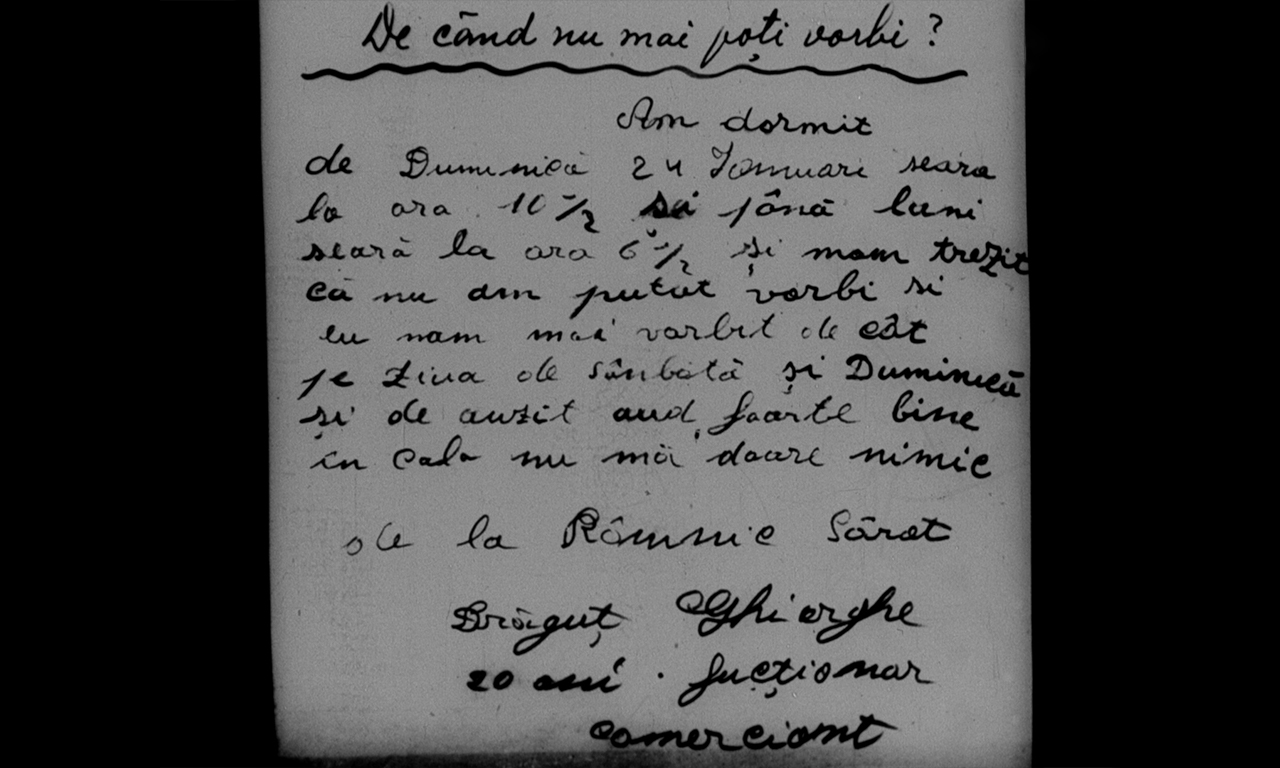Photosensitive Afflictions (1931)
15.09.2022
Photo credits: The National Film Archive
silent films, shorts, scientific medical documentaries conceived as teaching aids, runtime: 51:01 minutes
music: Irinel Anghel
guest: Valentin-Veron Toma (medical anthropologist at the Institute of Anthropology “Francisc I. Rainer” of the Romanian Academy)
Parkinson and Parkinsonism (Prof. Demetru Em. Paulian, Eftimie Vasilescu, 1931)*
Hemiplegia (Prof. Demetru Em. Paulian, Eftimie Vasilescu, 1931)*
Pithiatism – Hysteria (Prof. Demetru Em. Paulian, Eftimie Vasilescu, 1931)*
*digitized for the first time
Doctor Demetru Em. Paulian (1887-1949) was not only a revered medic, head of the Department of Neuroscience at the Central Hospital for Mental and Nervous Disorders for 23 years (1927-1949), “with more than appreciable clientele, a handsome man successful with the dames, and a resolute upstart” (Sașa Pană, Born in ’02), but also, it seems, a favored intellectual of the interwar gentlefolk, among those who threatened newness pen in hand. He was engaged, for instance, in the Maglavit matter, the great mystical controversy roused by the shepherd Petrache Lupu, that interwar screwball or saint, insisting on a pathological diagnosis, just as, three years prior, at the 12th Congress of the Romanian Society for Psychology and Endocrinology (1932), he’d proposed, less convincingly, a neurological diagnosis for the Dadaists. Not incidentally, having entered the Department of Neurology at St. Pantelimon Hospital, he professed under the direction of Gheorghe Marinescu, local pioneer of the scientific film, author, along with assistant Constantin Popescu, of several documentaries still preserved in the NFA’s collection, after their very tardy rediscovery (1973). Thirty years after Marinescu‘s experiments, Paulian would commence his own cinematographic documentation of Neurology patients, carrying out at least eight collaborations with operator Eftimie Vasilescu: Chorea, Hemiplegia, Myopathy, Myotonia, Parkinson and Parkinsonism, Pithiatism – Hysteria, Multiple Sclerosis and Neurosyphilis, made, according to the Archive’s dates, in ’31.
These all, but especially the three we’ve selected for the Photosensitive Afflictions cluster, concern to a great extent the project Fictitious Nonfiction precisely due to – or because of – the scientific zeal which made them possible. For Medicine has none of art’s interdicts, such that Paulian isn’t afraid to fret, to rile a reality for the screen, lining up his patients into a human chain of countenances for the camera. Once framed, all their glances, gestures, flinches, however faithful to the cruel lives these people have led, happen for the lens, as in a complete testimony to the state of being, setting nothing aside: the profilmic space (the camera’s horizon) is, in fact, the hospital patio, yet in thought it seems an endless stage that they do not exit, though the shot often stays still and uninterrupted. Watching these films from outside scientific circles, the fact that the patients tend to scrutinize the lens and the doctors to guard it from the corner of their eye enhances the strangeness of the process, betraying its irrepressible effort to make itself understood on-screen. How did disease strike these people, what were they before they were patients? Any medical record is a narration by omission, and such early documentaries incite the same fascination as tombstones: a time, a face, and all else comes of itself, from our incontrollable imaginary. All the more so since not all afflictions captured by Paulian are congenital, as it is mentioned right as Hemiplegia starts that one patient’s monoplegia was caused by a bullet, and in Hysteria we’re presented with the beginning and end of one case of neurological mutism. Perhaps the imaginary’s tic to narrativize seems pathological, but it concerns precisely the human side of these films and their reception.
“In photography, however, one encounters something strange and new: in that fishwife from Newhaven who looks at the ground with such relaxed and seductive shame something remains that does not testify merely to the art of the photographer Hill, something that is not to be silenced, something demanding the name of the person who had lived then, who even now is still real and will never entirely perish into art.” – Walter Benjamin, A Short History of Photography (Călin Boto)
Irinel Anghel (n. 1969) is an interdisciplinary artist, vocal performer, composer, sound artist, and performance artist. She has graduated from the National University of Music in Bucharest, the Musicology department (1994) and the Composition department (1996). She is Doctor in Musical Science since 2003 and graduate of the postdoctoral program (MIDAS) within NUMB (2013). Her compositional body includes instrumental, symphonic and theater music work. Her works have also relished in international success, being interpreted in Sweden, Germany, Belgium, France, Switzerland, the USA, Japan, etc. As of late, her activity has been dedicated to interdisciplinary, hybrid, fusion art and performance art, being a follower of experiential art with surrealist traits. She has been honored with numerous prizes: The “Uchimura” prize awarded by the National Theater Institute (UNESCO) for music for the theater show “The Crucified Lovers” (2002), the Creation prize – the musical work “Chimeres” (Pepinieres Europeennes pour Jeunes Artistes, Mons, Belgium), the Camajani Fellowship (New York University, 2003), The 2003 International New Music Consortium Award (New York), etc. The artistic director of the Săptămâna Internațională a Muzicii Noi festival (2010-2012). She is engaged in experimental projects, collaborating since 2017 with the death metal band Rotheads, and in 2019 with Torshanyio (Călin Torsan and Alexandru Hegyesi).
The films can be watched by children under the age of 12 only with parental consent or together with parents or family. These productions contain nudity scenes with no sexual connotations.
According to the contractual requirements imposed by the Romanian Film Center (RFC), we have separated the video source from the audio. The system of automatic synchronization, developed for the apps utilized, can present small delays depending on the (Internet) transfer speed and your device (desktop, phone, etc.).
To support our project click – here





